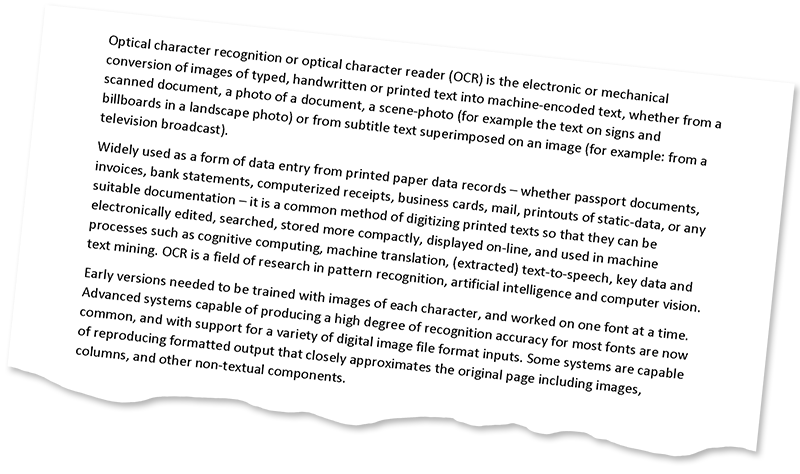Analyzing your prompt, please hold on...
An error occurred while retrieving the results. Please refresh the page and try again.
When a page is fed to a flatbed scanner (mechanically or manually) or photographed with a smartphone, it is nearly impossible to achieve perfect alignment. As a result, a slight skew (tilt) inevitably occurs in scanned images or photographs.
Skew angle detection and image straightening is critical to the OCR process as it directly affects the reliability and efficiency of segmentation and text extraction. Aspose.OCR offers automated processing algorithms to correct image tilt (deskew) before proceeding to recognition.
To find out skew angles for all images in a batch, use CalculateSkew method. It returns a list of SkewOutput objects, one per image, with the following properties:
| Property | Type | Description |
|---|---|---|
Angle |
double |
Skew angle in degrees. |
ImageIndex |
int |
Sequence number of the image on the page. When working with single-page images, this value is always 0. |
Page |
int |
Page number. When working with single-page images, this value is always 0. |
Source |
String |
The full path or URL of the source file. If the file is provided as a BufferedImage object, an array of pixels, or a Base64 string, this value will be empty. |
SkewOutput objects than the number of pages in the document.AsposeOcr recognitionEngine = new AsposeOcr();
// Add PDF documents to OcrInput object
OcrInput input = new OcrInput(InputType.PDF);
input.Add("source.pdf");
// Detect skew angles
ArrayList<SkewOutput> angles = recognitionEngine.CalculateSkew(input);
angles.forEach((angle) -> {
System.out.println("File: " + angle.Source + " | Page: " + angle.Page + " | Image: "+ angle.ImageIndex + " | Angle: " + angle.Angle +"°");
});

> File: "C:\source.pdf" | Page: 0 | Image: 0 | Angle: 5.9°To automatically straighten skewed image before recognition, run the image through AutoSkew preprocessing filter.
AsposeOCR api = new AsposeOCR();
// Apply automatic skew correction
PreprocessingFilter filters = new PreprocessingFilter();
filters.add(PreprocessingFilter.AutoSkew());
// Prepare batch
OcrInput images = new OcrInput(InputType.SingleImage, filters);
images.add("image.png");
// Save processed images to the folder
ImageProcessing.Save(images, "C:\\images");

In some cases, automatic skew correction may incorrectly determine the angle of the image. This can happen to significantly rotated images (more than 20% inclination) or poor quality photos with significant perspective distortions.
To deal with such situations, you can rotate the image by the specified degree using Rotate preprocessing filter. The rotation angle is passed in degrees:
-360 to 0): rotate counterclockwise;0 to 360): rotate clockwise.AsposeOCR api = new AsposeOCR();
// Apply manual rotation
PreprocessingFilter filters = new PreprocessingFilter();
filters.add(PreprocessingFilter.Rotate(-90));
// Prepare batch
OcrInput images = new OcrInput(InputType.SingleImage, filters);
images.add("image.png");
// Save processed images to the folder
ImageProcessing.Save(images, "C:\\images");
Automatic skew correction and manual rotation filters can be applied to specific regions of an image. For example, you can straighten an illustration on a page while leaving the rest of the content unchanged.
The original size of an image does not change when its area is rotated. Parts of the rotated area that do not match the original size of the area are cropped.
It is recommended to apply the automatic deskew and manual rotation filters only to square areas.
To apply a filter to an area, specify its top left corner along with width and height as Rectangle object. If the region is omitted, the filter is applied to the entire image.
Rectangle rectangle = new Rectangle(5, 161, 340, 340);
PreprocessingFilter filters = new PreprocessingFilter();
filters.add(PreprocessingFilter.Rotate(90, rectangle));
Analyzing your prompt, please hold on...
An error occurred while retrieving the results. Please refresh the page and try again.